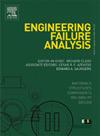Failure Analysis of Sulfur Solidification 2205 Duplex Stainless Steel Conveyor Belt
IF 5.7
2区 工程技术
Q1 ENGINEERING, MECHANICAL
引用次数: 0
Abstract
A sulfur solidification 2205 duplex stainless steel conveyor belt failed after 5 months of service. A detailed failure analysis was conducted to reveal the main cause of failure. The investigation included visual inspection, complete microstructural characterization and tensile testing. The study revealed that the main cause of failure was fatigue cracking. During installation, uncontrolled torch treatment was used to straighten wavy belt edges. This treatment led to the formation of intermetallic phases, carbide/oxide clusters, and residual stresses. Furthermore, the low nitrogen (N) content of the DSS belt promoted the formation of both intermetallic phases and carbide clusters. N is an austenite stabilizer, so low N decreases the amount of austenite and increases the ferrite phase, which is a preferential site for the formation of intermetallic phases and carbides. Interestingly, belt misalignment occurred, despite the presence of a self-alignment system, and combined with torch treatment to promote fatigue crack initiation and propagation. The existence of hard (α) and soft (ϒ) phases assisted fatigue crack initiation and propagation via α/ϒ separation boundaries, transgranular cracking, and accumulation of plastic deformation at the boundaries. Thus, this failure analysis proposed a possible fatigue failure mechanism for the 2205 DSS, which is considered unclear and is still an active research area. Moreover, there has not been any published literature on similar failure cases that encompass the combined effects of uncontrolled thermal repair, misalignment, and low nitrogen content on the fatigue cracking behavior of DSS conveyor belts in sulfur solidification environments, which emphasizes the novelty of this work. It is recommended to strictly follow the specified procedure for the installation and maintenance of DSS belts. A period of 2–3 weeks should be sufficient for regular maintenance. The optimal maintenance procedure should include regular cleaning of dirt, oil, grease, or any debris; appropriate examination for wear and tear; regular inspection for belt tension to prevent over-tensioning or slippage; systematic checks for alignment of the conveyor frame, drums and rollers; and proper inspection for alignment of the edge-seal support system. The conveyor system should employ center-to-center distances according to the pulley sizes and belt length, edge-seal support systems, belt trackers, belt scrapers, rigid and stable support systems, proper roller material, and closely stacked idle pulleys. Furthermore, the best 2205 DSS properties and minimum amounts of intermetallic phases should be ensured when the Cr, Mo, and N contents are within the upper half of the acceptable range. Therefore, the contents of Cr, Mo, and N should be at least 22–23 wt%, 3–3.5 wt%, and 0.14–0.2 wt%, respectively. The use of postrepair heat treatment is strongly not recommended. Additionally, it would be better to use other belt materials, such as austenitic stainless steels, e.g., AISI 301, which have higher resistance to fatigue.
2205双相不锈钢硫化输送带失效分析
硫磺凝固2205双相不锈钢输送带在使用5个月后失效。进行了详细的失效分析,揭示了失效的主要原因。调查包括目视检查,完整的显微组织表征和拉伸测试。研究表明,疲劳开裂是导致其失效的主要原因。在安装过程中,使用无控火炬处理来拉直波纹带边缘。这种处理导致了金属间相、碳化物/氧化物团簇和残余应力的形成。此外,低氮含量的DSS带促进了金属间相和碳化物簇的形成。N是一种奥氏体稳定剂,所以低N降低了奥氏体的数量,增加了铁素体相,这是金属间相和碳化物形成的优先位置。有趣的是,尽管存在自对准系统,但还是发生了皮带错位,并且结合火炬处理促进了疲劳裂纹的萌生和扩展。硬(α)相和软(γ)相的存在通过α/ γ分离边界、穿晶裂纹和边界处塑性变形的积累促进了疲劳裂纹的产生和扩展。因此,本失效分析提出了2205 DSS可能的疲劳失效机制,该机制目前尚不清楚,仍然是一个活跃的研究领域。此外,还没有任何关于类似失效案例的发表文献,包括不受控制的热修复、错位和低氮含量对硫凝固环境中DSS输送带疲劳开裂行为的综合影响,这强调了这项工作的新新性。建议严格按照规定的程序进行DSS皮带的安装和维护。定期保养2-3周就足够了。最佳的维护程序应该包括定期清洁污垢、油、油脂或任何碎屑;适当检查磨损情况;定期检查皮带张力,防止过张或打滑;系统检查输送机机架、滚筒和滚筒的对中;并对边缘密封支撑系统进行正确的检查。输送机系统应根据皮带轮尺寸和皮带长度采用中心到中心的距离、边缘密封支撑系统、皮带跟踪器、皮带刮削器、刚性和稳定的支撑系统、适当的托辊材料和紧密堆叠的空闲皮带轮。此外,当Cr、Mo和N含量在可接受范围的上半部分时,应确保2205 DSS性能最佳和金属间相数量最少。因此,Cr、Mo和N的含量应分别至少为22-23 wt%、3-3.5 wt%和0.14-0.2 wt%。强烈不建议使用修复后热处理。此外,最好使用其他皮带材料,如奥氏体不锈钢,如AISI 301,具有更高的抗疲劳性。
本文章由计算机程序翻译,如有差异,请以英文原文为准。
求助全文
约1分钟内获得全文
求助全文
来源期刊

Engineering Failure Analysis
工程技术-材料科学:表征与测试
CiteScore
7.70
自引率
20.00%
发文量
956
审稿时长
47 days
期刊介绍:
Engineering Failure Analysis publishes research papers describing the analysis of engineering failures and related studies.
Papers relating to the structure, properties and behaviour of engineering materials are encouraged, particularly those which also involve the detailed application of materials parameters to problems in engineering structures, components and design. In addition to the area of materials engineering, the interacting fields of mechanical, manufacturing, aeronautical, civil, chemical, corrosion and design engineering are considered relevant. Activity should be directed at analysing engineering failures and carrying out research to help reduce the incidences of failures and to extend the operating horizons of engineering materials.
Emphasis is placed on the mechanical properties of materials and their behaviour when influenced by structure, process and environment. Metallic, polymeric, ceramic and natural materials are all included and the application of these materials to real engineering situations should be emphasised. The use of a case-study based approach is also encouraged.
Engineering Failure Analysis provides essential reference material and critical feedback into the design process thereby contributing to the prevention of engineering failures in the future. All submissions will be subject to peer review from leading experts in the field.
 求助内容:
求助内容: 应助结果提醒方式:
应助结果提醒方式:


